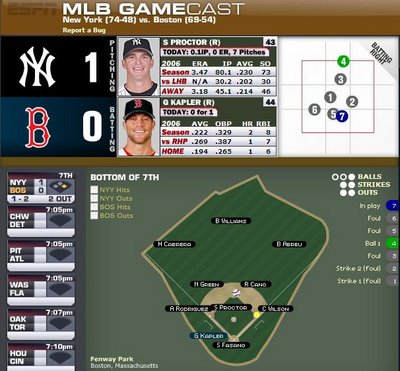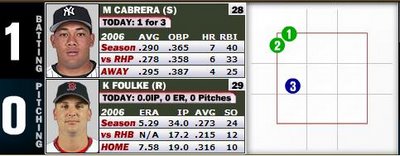Is either of these a Great, at-bat? Are both at least Good?
Following are back-to-back plate appearances in the current NY@BOS baseball game.
First, from the bottom of the seventh, Gabe Kapler v. Scott Proctor, just brought in for the Yankees in relief:

Note that he goes seven pitches, including one called a ball that appears to be on the strike area (but see NOTE below), against a new pitcher. The end result is P6, but it's a hard-working at-bat. Is it at least a good one? Does your answer change depending on whether you believe the fourth pitch should have been called a strike? Does it change back when you see Cabrera's at-bat?
The next at-bat is Nick Green, leading off the eighth inning for the Yankees against Boston starter David Wells:

Again, a lengthy at-bat (eight pitches, seven for strikes). The differences appear to be that the ball is clearly a ball, and the end result of the at-bat is a double to left field, after which Wells is relieved. (Green eventually scores the second, winning run for the Yankees on a wild pitch.)
Is an at-bat great only if it results in the batter reaching base (or at least advancing runners)? Is there a significant difference against a relief pitcher—that is, someone you're not likely to see again that game?
In this context, is Bob Klapisch's contention that the Yankees are a patient team likely to help them significantly in the playoffs?
Right now, I'm just asking. Maybe more later...
NOTE: As you can see from Cabrera's at-bat, the pitches on the border were consistently being called balls (which is what one expects from a home plate umpire: a consistent strike zone):

First, from the bottom of the seventh, Gabe Kapler v. Scott Proctor, just brought in for the Yankees in relief:

Note that he goes seven pitches, including one called a ball that appears to be on the strike area (but see NOTE below), against a new pitcher. The end result is P6, but it's a hard-working at-bat. Is it at least a good one? Does your answer change depending on whether you believe the fourth pitch should have been called a strike? Does it change back when you see Cabrera's at-bat?
The next at-bat is Nick Green, leading off the eighth inning for the Yankees against Boston starter David Wells:

Again, a lengthy at-bat (eight pitches, seven for strikes). The differences appear to be that the ball is clearly a ball, and the end result of the at-bat is a double to left field, after which Wells is relieved. (Green eventually scores the second, winning run for the Yankees on a wild pitch.)
Is an at-bat great only if it results in the batter reaching base (or at least advancing runners)? Is there a significant difference against a relief pitcher—that is, someone you're not likely to see again that game?
In this context, is Bob Klapisch's contention that the Yankees are a patient team likely to help them significantly in the playoffs?
Right now, I'm just asking. Maybe more later...
NOTE: As you can see from Cabrera's at-bat, the pitches on the border were consistently being called balls (which is what one expects from a home plate umpire: a consistent strike zone):




0 Comments:
Post a Comment
<< Home